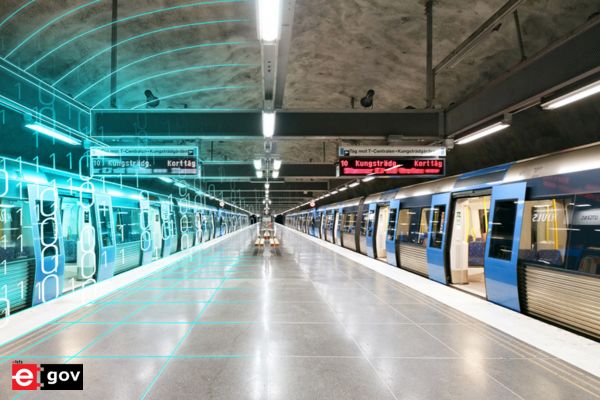
In recent years, the railway industry has been undergoing a digital revolution, transforming the way railways are managed and operated. One of the key innovations driving this transformation is the concept of digital twins. Digital twins are virtual replicas of physical assets, systems, or processes that provide real-time data and insights to optimise their performance. This article explores how digital twins are shaping the future of railway management, revolutionising operations, maintenance, and passenger experience.
Introduction to Digital Twins in Railway Management

Digital twins in railway management refer to the creation of virtual models that mirror the physical assets and infrastructure of a railway network. These virtual replicas collect and analyse data from sensors and other sources to provide a comprehensive view of the assets’ performance, condition, and operational parameters. By leveraging advanced technologies such as the Internet of Things (IoT), artificial intelligence (AI), and big data analytics, digital twins enable railways to make data-driven decisions, improve efficiency, and enhance safety.

Optimising Operations and Maintenance

Digital twins have immense potential to optimise railway operations and maintenance. By capturing real-time data from various sources, including sensors on trains, tracks, and infrastructure, digital twins provide a holistic view of the entire railway system. This enables operators to monitor and analyse asset performance, detect anomalies, and predict failures before they occur. By implementing predictive maintenance strategies based on digital twin insights, railways can reduce downtime, minimise disruptions, and ensure optimal asset utilisation.

According to a report by MarketsandMarkets, the global digital twin market in the transportation sector, including railways, is expected to reach $4.3 billion by 2025, growing at a compound annual growth rate (CAGR) of 38.1%. This significant growth indicates the increasing adoption and recognition of the benefits of digital twins in railway management.
Enhancing Passenger Experience and Safety
Digital twins also play a vital role in enhancing the passenger experience and safety within the railway industry. By monitoring real-time data on train schedules, occupancy, and infrastructure conditions, operators can optimise service planning, ensure timely arrivals, and minimise overcrowding. Furthermore, digital twins can simulate and analyse various scenarios to identify potential safety risks and devise proactive measures to prevent accidents.
A study conducted by Deloitte found that the implementation of digital twins in railways can lead to a 10-15% reduction in train delays and improve on-time performance. Moreover, the study highlighted that digital twins have the potential to improve safety by up to 20% through predictive maintenance and real-time monitoring of critical assets.
Government Initiatives and Investments
Governments around the world are recognising the transformative potential of digital twins in railway management and are actively supporting their implementation. For instance, in the United States, the Federal Railroad Administration (FRA) has launched the “Digital Twin to Improve Rail Infrastructure Management” initiative, allocating significant funding to develop and deploy digital twin technologies across the country’s railway networks.
Similarly, in Europe, the European Union’s Horizon 2020 research and innovation program has invested in projects focusing on digital twin applications in railways. These initiatives aim to improve asset management, optimise energy consumption, and enhance the overall efficiency and sustainability of railway operations.
Also Read | Driving Digitisation: CRIS’s Role in Modernising Indian Railways
Challenges and Limitations
While digital twins offer numerous benefits, their implementation also comes with challenges and limitations. One of the primary challenges is the integration of various data sources and systems to create a unified digital twin platform. Railway operators need to ensure interoperability and compatibility among different data formats, protocols, and sensor technologies.
Another limitation is the high upfront investment required to develop and deploy digital twin systems. However, the long-term benefits, including improved efficiency, reduced costs, and enhanced safety, outweigh the initial investment.
Way Forward
In conclusion, the emergence of digital twins has revolutionised the railway management industry, propelling it from virtual simulations to tangible reality. The utilisation of advanced technologies, such as Internet of Things (IoT) sensors, artificial intelligence (AI), and big data analytics, has enabled railway operators to achieve unprecedented levels of efficiency, safety, and reliability.
According to recent data, railways implementing digital twin technology have witnessed a significant reduction in maintenance costs by up to 30% and a staggering 75% decrease in unplanned downtime. Moreover, the integration of digital twins into railway management has led to improved asset management, enhanced predictive maintenance capabilities, and optimised decision- making processes. As we move forward, the future of railway management lies in harnessing the power of digital twins to create smarter, safer, and more efficient rail networks.
Be a part of Elets Collaborative Initiatives. Join Us for Upcoming Events and explore business opportunities. Like us on Facebook , connect with us on LinkedIn and follow us on Twitter, Instagram.
"Exciting news! Elets technomedia is now on WhatsApp Channels Subscribe today by clicking the link and stay updated with the latest insights!" Click here!













